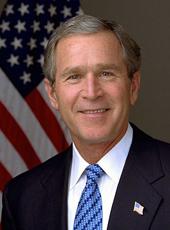
Fact Sheet: Twenty in Ten: Strengthening Energy Security and Addressing Climate Change
President Bush Directs Administration To Take The First Steps Toward Regulations Based On "Twenty In Ten" Goal
Today, President Bush Directed The U.S. Environmental Protection Agency (EPA) And The U.S. Departments Of Energy (DOE), Transportation (DOT), And Agriculture (USDA) To Take The First Steps Toward Regulations Using The "Twenty In Ten" Plan As A Starting Point. The President has directed these agencies to take the first steps toward regulations that would cut gasoline consumption and greenhouse gas emissions from motor vehicles, using as a starting point his "Twenty in Ten" plan to reduce U.S. gasoline consumption by 20 percent over the next 10 years.
- In The State Of The Union Address, The President Announced His "Twenty In Ten" Goal To Cut U.S. Gasoline Consumption By 20 Percent Over The Next Ten Years. By increasing the supply of alternative fuels and making motor vehicles more energy efficient, the President's "Twenty in Ten" plan provides a framework to address energy security and reduce greenhouse gas emissions from motor vehicles and off-road engines and equipment.
The Administration Has Sent Congress Legislative Proposals To Achieve "Twenty In Ten" With Two Steps:
- Increasing The Supply Of Renewable And Other Alternative Fuels By Setting A Mandatory Fuels Standard To Require The Equivalent Of 35 Billion Gallons Of Renewable And Other Alternative Fuels In 2017 – Nearly Five Times The 2012 Target Now In Law. In 2017, this will displace 15 percent of projected annual gasoline use.
- Reforming And Modernizing Corporate Average Fuel Economy (CAFE) Standards For Cars And Extending The Current Light Truck Rule. In 2017, this will reduce projected annual gasoline use by up to 8.5 billion gallons, a further 5 percent reduction that, in combination with increasing the supply of renewable and other alternative fuels, will bring the total reduction in projected annual gasoline use to 20 percent.
On April 2, 2007, The Supreme Court Ruled That The EPA Must Take Action Under The Clean Air Act Regarding Greenhouse Gas Emissions From Motor Vehicles.
- In Response To The Supreme Court's Ruling, The President Directed Cabinet Agencies To Take The First Steps Toward Regulations Based On "Twenty In Ten" That Will Make Our Economy Stronger, Our Environment Cleaner, And Our Nation More Secure For Generations To Come.
- The President Has Directed Members Of His Administration To Complete This Process By The End Of 2008. The President has asked Administration officials to listen to public input; carefully consider safety, science, and available technology; and evaluate benefits and costs before they reach any decisions. This is a complicated legal and technical matter that will take time to fully resolve. Yet it is important to move forward.
- The President Also Signed An Executive Order Requiring Coordination Among Federal Agencies Tasked With The Development Of Any Regulations Affecting Greenhouse Gas Emissions From Motor Vehicles. The Executive Order will ensure coordinated agency efforts on regulatory actions aimed at protecting the environment with respect to greenhouse gas emissions from motor vehicles, nonroad vehicles, and nonroad engines proceed in a manner consistent with sound science, analysis of benefits and costs, public safety, and economic growth.
The Steps The President Announced Today Are Not A Substitute For Effective Legislation. The Administration will redouble its efforts to work with Congress on a bipartisan "Twenty in Ten" bill.
Today's Actions Build On The President's Continued Commitment To Our Energy Security And Our Environment
Since The President Took Office, The Federal Government Has Invested $12 Billion To Develop Cleaner, Cheaper, And More Reliable Energy Sources. We have now reached a pivotal moment where advances in technology are creating new ways to improve energy security, strengthen national security, and protect the environment. The President's "Twenty in Ten" goal will help achieve all these priorities.
The President Has Devoted $37 Billion To Climate Change-Related Activities Since 2001. The President has requested an additional $7.4 billion for FY 2008 – $205 million more than this year. This amount would support a wide range of climate change-related research, development, and deployment programs, voluntary partnerships, and international aid efforts.
The President Has Twice Increased Fuel Economy Standards For Light Trucks, Covering Model Years From 2005 Through 2011. The two actions cumulatively raised light truck fuel economy standards from 20.7 mpg prior to 2005, to 24 mpg in 2011. These actions are expected to save 14 billion gallons of fuel over the life of the affected vehicles, and reduce net greenhouse gas emissions by 107 million metric tons of carbon dioxide equivalent.
We Are Well On Track To Meet – And Currently Projected To Exceed – The President's 2002 Goal Of Reducing U.S. Greenhouse Gas Emission Intensity 18 Percent By 2012. U.S. greenhouse gas intensity declined by 2.5 percent in 2005, much faster than the average decline of 1.9 percent over the 1990-2005 period.
George W. Bush, Fact Sheet: Twenty in Ten: Strengthening Energy Security and Addressing Climate Change Online by Gerhard Peters and John T. Woolley, The American Presidency Project https://www.presidency.ucsb.edu/node/284219
